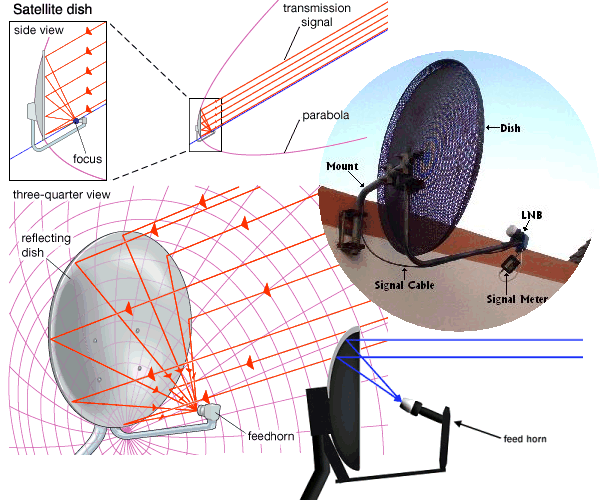Difference between revisions of "Television Satellite Dish Reference"
m (→Illustrated Dish Sizes) |
m (→cm / 13.5 x 15.5 in) |
||
| Line 108: | Line 108: | ||
sizes in width x height metric and us. | sizes in width x height metric and us. | ||
| − | === | + | === 34 x 39 cm / 13.5 x 15.5 in === |
{| | {| | ||
| [[Image:tvsatdishref0011.jpg]] | | [[Image:tvsatdishref0011.jpg]] | ||
Revision as of 22:19, 31 December 2007
A Satellite Dish is a type of antenna. Satellite dishes are often shaped like portions of a paraboloid (a parabola rotated about its central axis) in order to focus transmission signals onto the pickup receiver, or feedhorn. Typically, the section of the paraboloid used is offset from the centre so that the feedhorn and its support do not unduly block signals to the reflecting dish.
A satellite dish works similar to a TV antenna with the exception that it is intended to pick-up the weak ultra high frequency satellite transmissions, down-convert the frequency and place them on the coaxial cable. The Dish is made up of several components – The dish itself, an LNB and an actuator for motorised dishes.
The receiving dish works in the exact opposite way of the transmitter. When a beam hits the curved dish, the parabola shape reflects the radio signal inward onto a particular point, just like a concave mirror focuses light onto a particular point. The point is the dish's feed horn, which passes the signal on to the receiving equipment. In an ideal setup, there aren't any major obstacles between the satellite and the dish, so the dish receives a clear signal.
In some systems, the dish needs to pick up signals from two or more satellites at the same time. The satellites may be close enough together that a regular dish with a single horn can pick up signals from both. This compromises quality somewhat, because the dish isn't aimed directly at one or more of the satellites. A new dish design uses two or more horns to pick up different satellite signals. As the beams from different satellites hit the curved dish, they reflect at different angles so that one beam hits one of the horns and another beam hits a different horn.
The central element in the feed horn is the low noise blockdown converter, or LNB. The LNB amplifies the radio signal bouncing off the dish and filters out the noise (radio signals not carrying programming). The LNB passes the amplified, filtered signal to the satellite receiver inside the viewer's house.
Contents
- 1 How to calculate what size dish you need
- 2 Illustrated Dish Sizes
- 2.1 34 x 39 cm / 13.5 x 15.5 in
- 2.2 46 x 46 cm / 18 x 18 in
- 2.3 50.8 x 50.8 cm / 20 x 20 in
- 2.4 60 x 60 cm / 24 x 24 in
- 2.5 78.5 x 60.5 cm / 30.9 x 23.8 in
- 2.6 85 x 85 cm / 33.5 x 33.5 in
- 2.7 90 x 90 cm / 35.4 x 35.4 in
- 2.8 180 x 180 cm / 70.9 x 70.9 in
- 2.9 230 x 230 cm / 90 x 90 in
- 2.10 350 x 350 cm / 138 x 138 in
- 2.11 472 x 472 cm / 186 x 186 in
- 3 BUD: Big Ugly Dish
How to calculate what size dish you need
For Ku band reception within most of the continental US you can use a 75cm dish (2 1/2 foot). Fringe areas may need a 90cm or larger dish depending on which satellite your trying to obtain signal from. You can use this chart to double check to see if a 75cm dish will be large enough.
Having problems with a local city ordinance regulating dish size? That ordinance may be unenforceable! The FCC has passed rules to allow you to use up to a 39.37 inch dish (1 meter or 100 centimeters). The FCC rules may over ride any local regulations imposed on you.
| C-Band | Ku-Band | ||||
|---|---|---|---|---|---|
| EIRP (dBW) |
C Band Dish Size (meters) |
C Band Dish Size (Feet) |
EIRP (dBW) |
KU Dish Size (centimeter) |
KU Dish Size (inches) |
| 39.0 | 1.9 | 6.2 | 50.0 | 55 | 21.65 |
| 38.0 | 2.1 | 6.8 | 49.0 | 60 | 23.62 |
| 37.0 | 2.3 | 7.5 | 48.0 | 65 | 25.59 |
| 36.0 | 2.6 | 8.5 | 47.0 | 72 | 28.35 |
| 35.0 | 2.8 | 9.1 | 46.0 | 77 | 30.31 |
| 34.0 | 3.1 | 10.1 | 44.0 | 95 | 37.40 |
| 33.0 | 3.5 | 11.4 | 42.0 | 115 | 45.28 |
| 32.0 | 3.9 | 12.8 | 40.0 | 138 | 54.33 |
| 31.0 | 4.3 | 14.1 | 38.0 | 175 | 68.90 |
EIRP - Abbreviation for Effective-Isotropic-Radiated-Power
C Band - the frequencies in the 4 to 6 GHz range used both for terrestrial microwave links and satellite links
Ku Band - the frequency range from 10.5 to 17 GHz; in satellite communications, the frequency band 13.75 to 14.50 GHz for transmission, and 10.7 to 12.75 GHz for reception
Bigger is better and in fringe areas a slightly over sized dish will perform better in sever weather. For example, using a 1.2 meter dish in an area where a .98 meter dish would get you by can make a big difference in signal strength, clarity, and reliability.
Illustrated Dish Sizes
sizes in width x height metric and us.
34 x 39 cm / 13.5 x 15.5 in
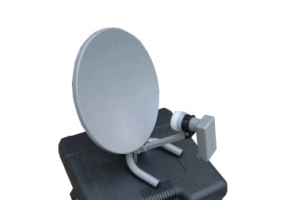
|
Example: Portable Camping Satellite Dish claims to have same signal strenght as an 18" dish this one includes dual LNB |
46 x 46 cm / 18 x 18 in
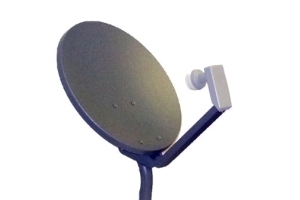
|
Example: Ariza single LNB dish |
50.8 x 50.8 cm / 20 x 20 in
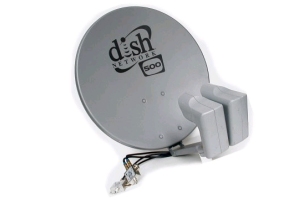
|
Example: Dish Network DISH 500 Antenna 20" Winegard Satellite DishPro Twin (for 110, 119) |
60 x 60 cm / 24 x 24 in
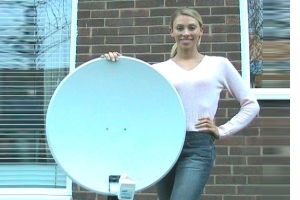
|
Example: Triax TD64 dish |
78.5 x 60.5 cm / 30.9 x 23.8 in
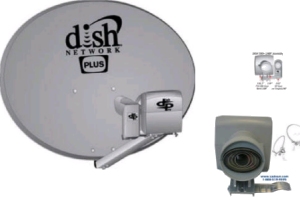
|
Example: Dish Network DISH 500 Plus Antenna |
85 x 85 cm / 33.5 x 33.5 in
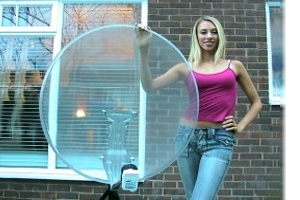
|
Example: Transparent 85cm dish |
90 x 90 cm / 35.4 x 35.4 in
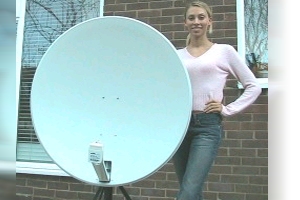
|
Example: Triax TD 78 |
180 x 180 cm / 70.9 x 70.9 in
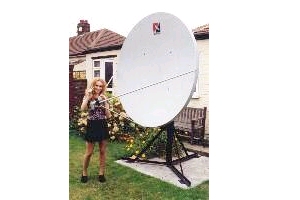
|
Example: 1.8m offset fixed Channel Master dish |
230 x 230 cm / 90 x 90 in
(2.3 meter / 7.5 ft)
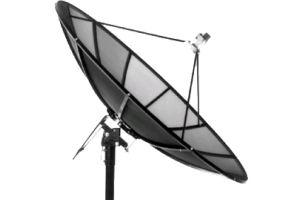
|
Example: 7.5' ft Sami C/Ku Band Antenna Model DS7.5 |
350 x 350 cm / 138 x 138 in
(3.5 meter / 11.5 ft)
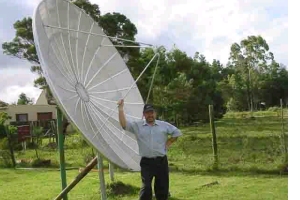
|
Example: 3.5 Meter Euro Aluminum Dish |
472 x 472 cm / 186 x 186 in
(4.7 meter / 14 ft)
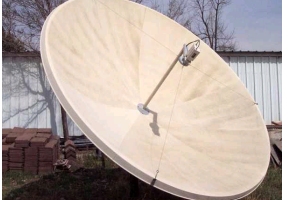
|
Example: 14' fiberglass |
BUD: Big Ugly Dish
A big ugly dish (often abbreviated to BUD) is a colloquial name for a satellite dish used to receive satellite television signals from FSS-type satellites on the C band. BUDs are usually about ten feet or three metres in diameter and have been a source of much consternation (even local zoning disputes) to neighbors of those with the dishes. Although some dishes are made of fiberglass, a common alternative is a metal mesh — such BUDs shed snow and suffer reduced wind loads; in addition, some critics consider them less unsightly.
Recently, DBS services have reduced or eliminated the need for BUDs. Signals from DBS satellites (operating in the Ku band) are higher in power and therefore require smaller dishes than C band, and the digital signals now used require far less signal strength at the receiver. General advancements in noise abatement have also had an effect. For these reasons, significantly smaller dishes are now used for home satellite reception.
A dual-band or Ku band LNB may be retrofitted to some big dishes, however there is a more restrictive maximum mesh size (anything less than the diameter of a pencil) if anything other than a solid dish is used at these shorter wavelengths. Usually, a solid fiberglass or spun aluminum dish is ideal for dual-band LNB operation.
